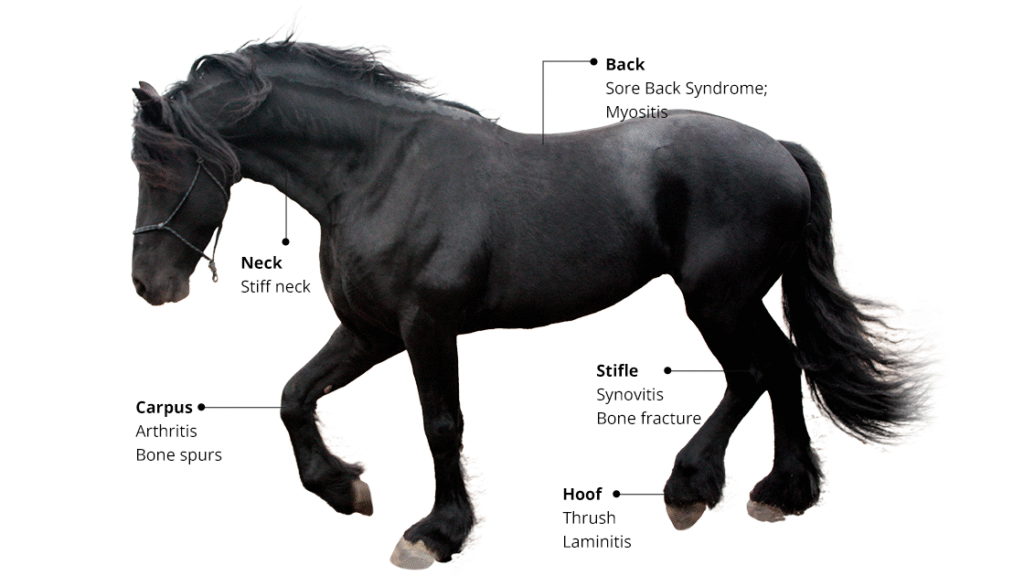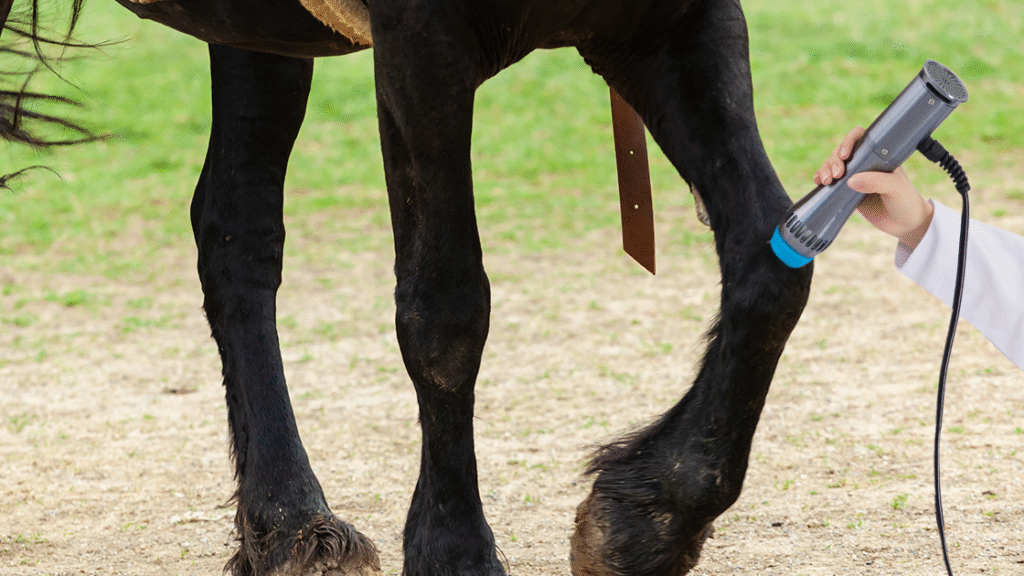Introduction: Understanding Shockwave Therapy for Horses
As veterinary medicine continues to evolve, innovative treatments are revolutionizing how we approach equine healthcare. Among these groundbreaking therapies, extracorporeal shockwave therapy (ESWT) has emerged as a game-changing treatment modality that offers new hope for horses suffering from various musculoskeletal conditions. This non-invasive therapeutic approach has gained significant traction among veterinary professionals worldwide, transforming the landscape of equine rehabilitation and pain management.
What is Shockwave Therapy?
Extracorporeal shockwave therapy represents a sophisticated medical treatment that harnesses the power of high-energy acoustic waves to stimulate the body’s natural healing mechanisms. These acoustic waves, generated by specialized equipment, penetrate approximately 4-6 centimeters into tissue at frequencies ranging from 1-16 Hz. The therapeutic mechanism involves four distinct phases: physical, physicochemical, chemical, and biological. During the physical phase, shockwaves create positive pressure that facilitates energy transmission within tissues and cells while enhancing membrane permeability. The treatment triggers immediate cellular responses, promoting angiogenesis, reducing inflammation, and accelerating tissue regeneration in both hard and soft tissues.
The Role of Shockwave Therapy in Equine Medicine
In contemporary equine veterinary practice, shockwave therapy has established itself as an indispensable tool for treating various orthopedic conditions. The therapy’s ability to stimulate healing without invasive procedures makes it particularly valuable for treating performance horses where maintaining athletic capacity is paramount. Veterinarians utilize ESWT primarily for addressing lameness issues, with particular emphasis on arthritis management and ligament injury treatment. The acoustic waves generate localized heat, increasing tissue temperature above 30°C, which promotes enhanced blood circulation and activates collagen synthesis within fibrous connective tissues.
Why Veterinarians Recommend Shockwave Therapy for Horses
The growing endorsement of shockwave therapy among veterinary professionals stems from its remarkable clinical efficacy and minimal side effect profile. Unlike traditional treatments that may require lengthy recovery periods or carry surgical risks, ESWT offers a non-invasive alternative that can be administered in clinical settings without anesthesia. The therapy’s ability to target specific anatomical structures while promoting comprehensive healing makes it an attractive option for treating chronic conditions that have proven resistant to conventional therapies. Additionally, the treatment’s capacity to stimulate cellular proliferation and enhance the expression of healing-promoting genes provides long-lasting therapeutic benefits.
Common Conditions in Horses Treated with Shockwave Therapy
The versatility of shockwave therapy in equine medicine extends across numerous pathological conditions, each presenting unique challenges that this innovative treatment effectively addresses. Understanding these conditions and their response to ESWT enables veterinarians to develop comprehensive treatment protocols that maximize therapeutic outcomes while minimizing patient discomfort.

Treating Soft Tissue Injuries with Shockwave Therapy
Soft tissue injuries represent one of the most common applications for shockwave therapy in equine practice. These injuries, including muscle strains, ligament sprains, and fascial restrictions, respond exceptionally well to acoustic wave treatment. The therapy works by breaking down damaged scar tissue and triggering the body’s repair mechanisms through controlled energy delivery. The acoustic waves stimulate fibroblast activity, promoting collagen synthesis and tissue remodeling. This process helps restore normal tissue architecture and function while reducing adhesion formation that commonly complicates soft tissue healing in horses.
Managing Joint Pain and Arthritis in Horses
Arthritis and joint-related pain conditions present significant challenges in equine medicine, particularly in aging horses and those with extensive athletic careers. Shockwave therapy offers remarkable benefits for these conditions by targeting the underlying inflammatory processes and promoting cartilage health. The treatment increases chondrocyte activity, reducing cartilage fissuring and preventing cell death associated with degenerative joint disease. ESWT demonstrates consistent chondroprotective effects regardless of arthritis stage, making it valuable for both early intervention and advanced disease management. The therapy’s anti-inflammatory properties provide sustained pain relief while improving joint mobility and function.
Shockwave Therapy for Hoof and Tendon Injuries
Hoof and tendon injuries pose particular challenges due to the limited blood supply in these anatomical regions, which traditionally results in prolonged healing times. Shockwave therapy addresses this limitation by stimulating neovascularization and enhancing local blood flow to the affected areas. For conditions such as suspensory ligament injuries, digital flexor tendonitis, and navicular syndrome, ESWT promotes tissue regeneration while reducing chronic inflammation. The therapy’s ability to penetrate deep tissues makes it particularly effective for addressing core lesions within tendons that are often difficult to treat with topical applications or conventional therapies.
Addressing Back Pain and Spinal Issues in Horses
Spinal conditions, including the commonly encountered “kissing spines” (overriding dorsal spinous processes), represent another area where shockwave therapy demonstrates exceptional therapeutic value. This painful condition occurs when adjacent vertebrae make contact, causing inflammation and severe discomfort that significantly impacts performance and quality of life. ESWT provides targeted treatment by delivering acoustic waves directly to the affected spinal segments, promoting tissue healing while reducing inflammatory responses. The therapy’s non-invasive nature makes it particularly suitable for treating spinal conditions where surgical intervention carries inherent risks and prolonged recovery periods.
Pre- and Post-Treatment Care for Horses Undergoing Shockwave Therapy
Successful shockwave therapy outcomes depend not only on proper treatment administration but also on comprehensive pre- and post-treatment care protocols. These protocols ensure optimal therapeutic conditions while minimizing potential complications and maximizing healing potential throughout the treatment process.
Preparing Horses for Shockwave Therapy
Proper preparation begins with thorough diagnostic evaluation to confirm treatment candidacy and identify any contraindications. Horses should undergo complete physical examination, including detailed lameness evaluation and diagnostic imaging when appropriate. Pre-treatment preparation includes ensuring the horse is calm and comfortable, as stress can interfere with treatment efficacy. The treatment area should be cleaned and clipped to ensure optimal acoustic wave transmission. Sedation is typically unnecessary, but anxious horses may benefit from mild tranquilization. Veterinarians should discuss treatment expectations with owners, explaining the typical response timeline and number of sessions required for optimal outcomes.
Post-Treatment Care and Recovery Tips
Post-treatment care protocols play a crucial role in maximizing therapeutic benefits and preventing complications. Immediately following treatment, horses should be monitored for any adverse reactions, though these are rare with properly administered ESWT. A brief period of controlled exercise, typically hand-walking, helps promote circulation and tissue healing. Anti-inflammatory medications should be avoided for 24-48 hours post-treatment to allow the natural inflammatory healing response to occur. Owners should maintain detailed records of the horse’s response, including changes in comfort level, mobility, and performance. Regular follow-up examinations allow veterinarians to assess progress and adjust treatment protocols as needed.
Monitoring Results: Assessing the Effectiveness of Shockwave Therapy
Systematic monitoring of treatment response is essential for determining therapeutic efficacy and guiding future treatment decisions. Veterinarians typically employ multiple assessment methods, including objective lameness evaluation, diagnostic imaging, and performance metrics. Clinical improvement often begins within days of treatment, with continued enhancement over several weeks. Owners should document daily observations regarding the horse’s comfort level, willingness to move, and behavioral changes. Follow-up examinations typically occur at two-week intervals initially, with frequency adjusted based on response patterns. Long-term monitoring helps identify horses that may benefit from maintenance treatments or additional therapeutic interventions.
Veterinarian’s Perspective: Shockwave Therapy Case Studies
Real-world case studies provide invaluable insights into the practical applications and outcomes of shockwave therapy in equine practice. These clinical examples demonstrate the therapy’s versatility and effectiveness across diverse conditions and patient populations, offering evidence-based support for treatment decisions.
Case Study 1: Recovery from Tendon Injury in an Athlete Horse
A seven-year-old Thoroughbred racehorse presented with acute superficial digital flexor tendonitis in the left forelimb, diagnosed through ultrasonographic examination revealing a core lesion with significant fiber disruption. Traditional treatment approaches had yielded limited improvement over six weeks. Shockwave therapy was initiated using a focused approach targeting the lesion site with three treatment sessions at two-week intervals. Post-treatment monitoring revealed progressive improvement in ultrasonographic appearance, with increased echogenicity and fiber realignment. The horse returned to training within twelve weeks and successfully competed at previous performance levels. This case demonstrates ESWT’s ability to accelerate healing in acute tendon injuries while maintaining tissue integrity for athletic performance.
Case Study 2: Treating Chronic Joint Pain in an Older Horse
An eighteen-year-old warmblood horse with chronic osteoarthritis in multiple joints presented with progressive lameness and reduced quality of life despite conventional management. Radiographic examination revealed moderate to severe degenerative changes in the fetlock and pastern joints. A comprehensive shockwave therapy protocol was implemented, consisting of four treatment sessions targeting affected joints at three-week intervals. Clinical assessment revealed significant improvement in comfort levels and mobility within six weeks of initiating treatment. The horse demonstrated sustained improvement over twelve months with quarterly maintenance treatments. This case illustrates ESWT’s effectiveness in managing chronic degenerative conditions and improving geriatric horse welfare.
Case Study 3: Managing Hoof Infections and Tendon Strain
A twelve-year-old quarter horse developed a deep digital flexor tendon strain complicated by secondary hoof abscess formation. The complex nature of the condition required integrated therapeutic approach combining antimicrobial therapy with regenerative treatment. Shockwave therapy was applied to both the tendon injury and surrounding hoof structures using modified protocols adapted for the dual pathology. Treatment sessions were scheduled weekly for four weeks, with careful monitoring for infection resolution. The combined approach resulted in complete abscess resolution and significant tendon healing within eight weeks. Return to normal activity occurred at twelve weeks with no recurrence of either condition.

Top 5 Benefits of Shockwave Therapy for Horses
The widespread adoption of shockwave therapy in equine veterinary medicine reflects its numerous therapeutic advantages over conventional treatment modalities. These benefits extend beyond simple symptom management to address underlying pathophysiological processes that drive disease progression and limit healing potential.
Pain Relief and Improved Mobility
Pain reduction represents one of the most immediate and noticeable benefits of shockwave therapy in equine patients. The analgesic effects result from multiple mechanisms, including desensitization of pain receptors, modulation of nerve transmission, and reduction of inflammatory mediators. Horses typically demonstrate improved comfort levels within days of treatment, with progressive enhancement over subsequent weeks. The pain relief is often accompanied by increased willingness to move and improved gait quality. Unlike pharmaceutical pain management, ESWT-induced analgesia does not carry risks of systemic side effects or drug interactions, making it suitable for long-term management of chronic conditions.
Accelerating Healing and Tissue Regeneration
The regenerative properties of shockwave therapy represent its most significant therapeutic advantage, promoting healing at the cellular level through multiple pathways. Acoustic waves stimulate the release of growth factors, including ATP, which activate cellular signaling cascades essential for tissue repair. The therapy enhances angiogenesis, establishing improved blood supply to healing tissues while promoting collagen synthesis and tissue remodeling. This accelerated healing process is particularly valuable for treating conditions with historically poor healing potential, such as tendon core lesions and cartilage damage. The enhanced healing capacity often results in stronger, more resilient tissue architecture compared to natural healing processes.
Non-invasive and Drug-free Treatment Option
The non-invasive nature of shockwave therapy offers significant advantages over surgical interventions and pharmaceutical treatments commonly used in equine medicine. Treatment can be performed in clinical settings without anesthesia, reducing procedural risks and eliminating recovery periods associated with surgical procedures. The absence of drug administration eliminates concerns about withdrawal periods for competition horses and reduces risks of adverse drug reactions. This characteristic makes ESWT particularly valuable for treating performance horses where maintaining training schedules and competition eligibility are paramount concerns. The treatment’s safety profile allows for repeated applications when necessary without cumulative toxicity risks.
Enhancing Circulation and Reducing Inflammation
Shockwave therapy’s vascular effects contribute significantly to its therapeutic efficacy by addressing the circulatory limitations that often impede healing in equine musculoskeletal conditions. The acoustic waves stimulate vasodilation and promote the formation of new blood vessels, enhancing nutrient and oxygen delivery to healing tissues. Simultaneously, the therapy modulates inflammatory responses, reducing excessive inflammation while preserving beneficial healing processes. This balanced approach to inflammation management is particularly important in chronic conditions where persistent inflammation contributes to tissue damage and pain. The improved circulation also facilitates the removal of metabolic waste products that can accumulate in injured tissues.
Shorter Recovery Time and Fewer Side Effects
The accelerated healing promoted by shockwave therapy translates into significantly reduced recovery times compared to conventional treatment approaches. This benefit is particularly important for performance horses where extended periods of inactivity result in deconditioning and lost training time. The therapy’s excellent safety profile means that adverse effects are rare and typically limited to mild, transient reactions at the treatment site. Unlike many conventional treatments, ESWT does not require lengthy rest periods or activity restrictions, allowing horses to maintain appropriate exercise levels throughout the healing process. The reduced recovery time also minimizes the psychological stress often associated with prolonged confinement in horses.
Conclusion: Why Shockwave Therapy is a Game Changer for Horse Health
The integration of shockwave therapy into contemporary equine veterinary practice represents a paradigm shift in how we approach musculoskeletal conditions in horses. This innovative treatment modality addresses the fundamental limitations of traditional therapeutic approaches by promoting healing at the cellular level while providing immediate symptomatic relief.
The Long-term Impact of Shockwave Therapy on Horse Wellness
The long-term implications of shockwave therapy extend far beyond immediate clinical improvements, fundamentally altering the trajectory of chronic conditions and age-related changes in horses. By promoting tissue regeneration and modulating inflammatory processes, ESWT helps maintain structural integrity and function throughout the horse’s life. The therapy’s ability to enhance healing quality often results in more resilient tissues that are better equipped to withstand future stresses and injuries. For performance horses, this translates into extended athletic careers with reduced risk of recurrent injuries. In geriatric horses, ESWT can significantly improve quality of life by managing degenerative conditions that would otherwise limit mobility and comfort.
Final Thoughts: Is Shockwave Therapy Right for Your Horse?
Determining the appropriateness of shockwave therapy for individual horses requires careful consideration of multiple factors, including specific condition characteristics, treatment goals, and patient factors. Horses with acute injuries often respond more rapidly than those with chronic conditions, though both groups can benefit significantly from treatment. The therapy is particularly valuable for conditions with limited treatment options or those that have proven resistant to conventional approaches. Age is rarely a limiting factor, as both young performance horses and geriatric patients can safely receive treatment. The decision should always be made in consultation with qualified veterinary professionals who can assess individual circumstances and develop appropriate treatment protocols.
FAQs: Common Questions About Shockwave Therapy for Horses
Shockwave therapy can be an effective alternative to surgery in many cases, especially for soft tissue injuries like tendonitis or ligament damage. It promotes healing without the need for invasive procedures. However, severe injuries may still require surgical intervention, so a veterinary assessment is essential for determining the best treatment option.
The number of sessions required can vary depending on the injury’s severity and the horse’s response to treatment. Typically, 3 to 6 sessions spaced a week apart are common for optimal results. Your veterinarian will tailor the treatment plan to your horse’s specific needs and track progress.
Shockwave therapy is generally not painful, though some horses may experience mild discomfort during the procedure. Most horses tolerate it well, and it is often described as a deep pressure or tingling sensation. Veterinarians may apply a local anesthetic to reduce any potential discomfort, ensuring the horse’s comfort.
While some horses may show immediate signs of improvement after a session, most horses require a few weeks to fully experience the benefits. Increased mobility, reduced inflammation, and pain relief generally become noticeable within 3-7 days after the first few treatments.
Shockwave therapy is generally considered safe, with minimal side effects. However, excessive or incorrect application can sometimes lead to mild bruising or temporary soreness in the treated area. Long-term risks are extremely rare, and most horses experience a significant improvement in mobility and comfort after treatment.
Yes, shockwave therapy can be safely used on horses of various ages, breeds, and activity levels. Whether it’s a young competition horse with an acute injury or an older horse suffering from chronic arthritis, shockwave therapy can provide relief and improve healing. Your veterinarian will adjust the treatment based on the horse’s individual health and condition.
References & Further Reading
- Why Every Horse Owner Should Consider Shockwave Therapy
- What is shockwave therapy for horses?
- Boost Your Horse’s Wellness: Shockwave Therapy for Equine Health
- Shockwave Therapy for Veterinary Use
- Equine shock wave therapy – where are we now?
Extracorporeal Shockwave Therapy Increases Growth Factor Release from Equine Platelet-Rich Plasma In Vitro
